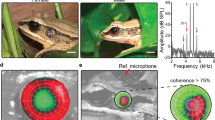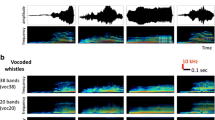Summary
Horseshoe bats (Rhinolophus rouxi) were deafened in their 3rd–5th postnatal week. Subsequently their vocalisations were monitored to evaluate the impact of audition on the development of echolocation pulses. Hearing impairment affected the echolocation pulses as follows: the frequency of the constant frequency (CF) component was altered by between + 4 kHz and − 14 kHz, and the dominance of the second harmonic of the pulses was neutralised by a relative increase in intensity of the first and third harmonics.
A second experiment focused on possible influences of acoustical self-stimulation with echolocation pulses on the establishment of auditory fovea representation in the inferior colliculus (IC). Frequency control of echolocation pulses was disrupted by larynx denervation. Thereafter, the bats produced multiharmonic echolocation signals (4–11 harmonics) varying in frequency. IC tonotopy, however, as monitored by stereotaxic electrophysiology, showed the same developmental dynamics as seen in control specimens (Fig. 10).
Both experiments indicate that throughout postnatal development echolocation pulses are under auditory feedback control, whereas maturation of the auditory fovea and shifts in its frequency tuning represent an innate process. The significance of this postnatal development might be the adjustment of the vocal motor system of each bat to the frequency of its ‘personal’ auditory fovea.
Similar content being viewed by others
Abbreviations
- CF :
-
constant frequency
- CF1, CF2, CF3 :
-
harmonics of pure tone components of the echolocation pulses
- FM :
-
frequency modulation
- IC :
-
inferior colliculus of the midbrain
References
Galambos R (1942) The avoidance of obstacles by flying bats: Spallanzani's ideas (1794) and later theories. Isis 34:132–140
Griffin DR (1974a) Listening in the dark. Dover, New York, pp 81–119
Griffin DR (1974b) Listening in the dark. Dover, New York, pp 57–81
Hartley DJ, Suthers RA (1988) The acoustics of the vocal tract in the horseshoe bat, Rhinolophus hildebrandti. J Acoust Soc Am 84:1201–1213
Knipschild M (1988) Krapkoe rukovodstvo k sisteme SAP: Sona. Bjuleten' Foneticeskogo Fonda 1:57–64
Metzner W (1988) Die funktionelle Bedeutung tegmentaler Neurone bei der Echoortung der Hufeisennase Rhinolophus rouxi (Chiroptera). Dissertation, Ludwig-Maximilians-Universität, Munich
Metzner W (1989) A possible neuronal basis for Doppler-shift compensation in echolocating horseshoe bats. Nature 341:529–532
Neuweiler G, Metzner W, Heilmann U, Rübsamen R, Eckrich M, Costa HH (1987) Foraging behaviour and echolocation in the rufous horseshoe bat (Rhinolophus rouxi) in Sri Lanka. Behav Ecol Sociobiol 20:53–67
Nottebohm F (1970) Ontogeny of bird song. Science 167:950–956
Romand R, Ehret G (1984) Development of sound production in normal, isolated, and deafened kittens during the first postnatal month. Devel Psychobiol 17:629–649
Rübsamen R (1987) Ontogenesis of the echolocation system in the rufous horseshoe bat, Rhinolophus rouxi. (Audition and vocalization in early postnatal development). J Comp Physiol A 161:899–913
Rübsamen R, Schäfer M (1990) Ontogenesis of auditory fovea representation in the inferior colliculus of the Sri Lankan rufous horseshoe bat, Rhinolophus rouxi. J Comp Physiol A 167:757–769
Rübsamen R, Schuller G (1981) Laryngeal nerve activity during pulse emission in the CF-FM bat, Rhinolophus ferrumequinum. II. The recurrent laryngeal nerve. J Comp Physiol 143:323–327
Rübsamen R, Neuweiler G, Sripathi K (1988a) Comparative collicular tonotopy in two bat species adapted to movement detection, Hipposideros speoris and Megaderma lyra. J Comp Physiol A 163:271–285
Rübsamen R, Schäfer M, Neuweiler G (1988b) Spatial frequency representation in the auditory midbrain of the rufous horseshoe bat Rhinolophus rouxi. In: Elsner N, Creutzfeldt OD (eds) New frontiers in brain research, Proc 15th Göttingen Neurobiol Conf. G Thieme, Stuttgart, p 196
Rübsamen R, Neuweiler G, Marimuthu G (1989) Ontogenesis of tonotopy in inferior colliculus of a hipposiderid bat reveals postnatal shift in frequency place code. J Comp Physiol A 165:755–769
Schnitzler HU (1968) Die Ultraschall-Ortungslaute der Hufeisenfledermäuse (Chiroptera-Rhinolophidae) in verschiedenen Orientierungssituationen. Z Vergl Physiol 57:376–408
Schuller G (1979) Vocalization influences auditory processing in collicular neurons of the CF-FM bat, Rhinolophus ferrumequinum. J Comp Physiol 132:39–46
Schuller G (1986) Influence of echolocation pulse rate on Doppler shift compensation control system in the greater horseshoe bat. J Comp Physiol A 158:239–246
Schuller G, Pollak G (1979) Disproportionate frequency representation in the inferior colliculus of Doppler compensating greater horseshoe bats. Evidence for an acoustic fovea. J Comp Physiol 132:47–54
Schuller G, Rübsamen R (1981) Laryngeal nerve activity during pulse emission in the CF-FM bat, Rhinolophus ferrumequinum. I. Superior laryngeal nerve (External motor branch). J Comp Physiol 143:317–321
Schuller G, Suga N (1976a) Storage of Doppler-shift information in the echolocation system of the ‘CF-FM’-bat, Rhinolophus ferrumequinum. J Comp Physiol 105:9–14
Schuller G, Suga N (1976b) Laryngeal mechanisms for the emission of CF-FM sounds in the Doppler-shift compensating bat, Rhinolophus ferrumequinum. J Comp Physiol 107:253–262
Schuller G, Beuter K, Schnitzler HU (1974) Response to frequency shifted artificial echoes in the bat, Rhinolophus ferrumequinum. J Comp Physiol 89:275–286
Schuller G, Beuter K, Rübsamen R (1975) Dynamic properties of the compensation system for Doppler shifts in the bat, Rhinolophus ferrumequinum. J Comp Physiol 97:113–125
Vater M, Rübsamen R (1989) Postnatal development of the cochlea in horseshoe bats. In: Wilson JP, Kemp DT (eds) Mechanics of hearing. Plenum, New York (in press)
Vater MJ, Feng AS, Betz M (1985) An HRP-study of the frequency-place map of the horseshoe bat cochlea: morphological correlates of the sharp tuning to a narrow frequency band. J Comp Physiol A 157:671–686
Winter P, Handley R, Ploog D, Schott D (1973) Ontogeny of squirrel monkey calls under normal conditions and under acoustic isolation. Behaviour 47:230–239
Author information
Authors and Affiliations
Rights and permissions
About this article
Cite this article
Rübsamen, R., Schäfer, M. Audiovocal interactions during development? Vocalisation in deafened young horseshoe bats vs. audition in vocalisation-impaired bats. J Comp Physiol A 167, 771–784 (1990). https://doi.org/10.1007/BF00189767
Accepted:
Issue Date:
DOI: https://doi.org/10.1007/BF00189767




